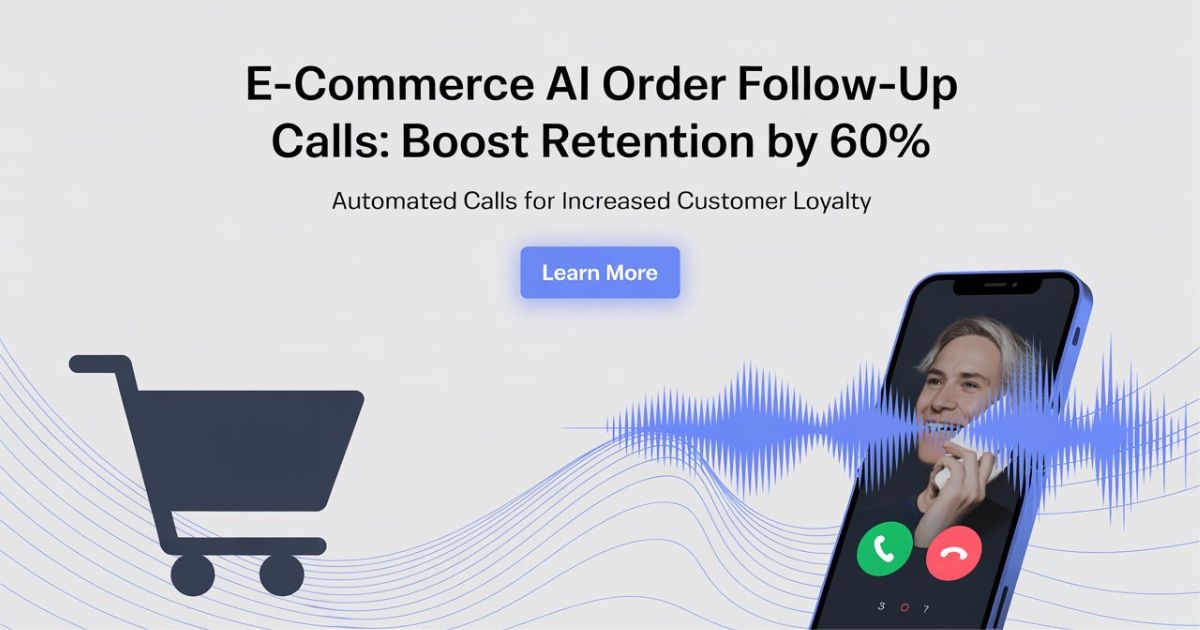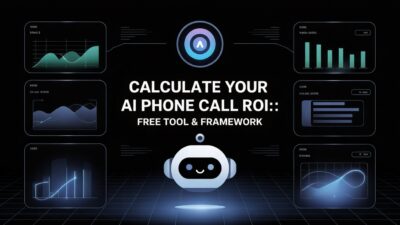E-commerce AI order follow-up calls are transforming how businesses connect with customers after the sale. Imagine this: Your customer just bought a $300 coffee machine from your online store. Three days later, they’re struggling to set it up, getting frustrated, and considering returning it. Meanwhile, you have no idea they’re having problems because you’re too busy processing new orders to follow up on recent ones.
Table of Contents
This scenario plays out thousands of times daily across e-commerce businesses. Companies spend fortunes acquiring customers, then lose them due to poor post-purchase experiences. But what if you could automatically reach out to every customer, solve their problems before they escalate, and turn one-time buyers into loyal advocates?
That’s exactly what e-commerce AI order follow-up calls accomplish. Forward-thinking online retailers are using AI to personally connect with customers after purchase, and the results are staggering: 60% increases in customer retention, 40% boosts in repeat purchases, and dramatic improvements in customer satisfaction scores.
The secret isn’t just technology – it’s understanding that the sale is just the beginning of the customer relationship. Let’s explore how AI follow-up calls are transforming e-commerce customer retention and why your business needs this strategy.
Why You Need E-commerce AI Order Follow-Up Calls
E-commerce has a dirty secret: most businesses are terrible at keeping customers. Industry averages show that only 27% of e-commerce customers make a second purchase, and just 13% become truly loyal repeat buyers. Companies spend 5-10 times more on acquiring new customers than on retaining existing ones, yet most put minimal effort into post-purchase engagement.
Why Traditional Follow-Up Fails Without E-commerce AI Order Follow-Up Calls
- Manual Impossibility: Imagine trying to personally call every customer who buys from your online store. For businesses processing hundreds or thousands of orders weekly, human follow-up is impossible. You’d need an army of customer service representatives, and the costs would be astronomical.
- Timing Problems: When human teams do attempt follow-up, they often miss the crucial windows. Calling too soon feels pushy, and calling too late means problems have already escalated. Finding the perfect timing for each product and customer type requires more precision than manual systems can provide.
- Inconsistent Messaging: Different representatives deliver different messages, ask different questions, and provide varying levels of service. This inconsistency creates confusion and missed opportunities to address customer needs effectively.
- Limited Scalability: Human follow-up doesn’t scale. As your business grows, the gap between order volume and follow-up capacity widens. You end up helping fewer customers proportionally as you get busier.
- Resource Allocation: Manual follow-up requires significant human resources that could be better spent on complex customer issues, product development, or business growth activities.
The Real Cost of Skipping E-commerce AI Order Follow-Up Calls
The numbers are sobering. Research shows that 67% of customers who have a negative post-purchase experience never buy from that company again. Even worse, they tell an average of 15 people about their bad experience, creating a ripple effect of lost potential customers.
Consider these real costs:
- A customer who would have spent $2,000 over their lifetime is lost forever
- Negative reviews hurt your search rankings and conversion rates
- Word-of-mouth damage affects your brand reputation
- Increased return rates eat into profit margins
- Customer acquisition costs rise as reputation suffers
The opportunity cost is even higher. Happy customers don’t just buy again – they become brand ambassadors, referring friends and family while spending 67% more than new customers on average.
How E-commerce AI Order Follow-Up Calls Work
AI follow-up calls transform post-purchase engagement from an impossible task into an automated, personalized system that reaches every customer at the perfect moment.
Intelligent Timing Algorithms
AI systems analyze multiple factors to determine optimal call timing for each customer and product:
- Product Complexity: Simple items like books or clothing might get follow-up calls within 24-48 hours to confirm satisfaction. Complex products like electronics or furniture might be contacted after 3-5 days, allowing time for setup and initial use.
- Delivery Confirmation: AI systems integrate with shipping data to call customers shortly after confirmed delivery, when the product experience is fresh but they’ve had time to unpack and try it.
- Customer Behavior Patterns: The AI learns when different customer segments prefer to receive calls, avoiding inconvenient times and maximizing connection rates.
- Historical Data: Past interaction data helps AI systems predict the best timing for follow-up based on similar customers and products.
Personalized Conversation Flows
Unlike generic customer service scripts, AI follow-up calls adapt to each specific purchase and customer:
- Product-Specific Questions: Someone who bought a blender gets asked about recipe preferences and blending performance. A customer who purchased running shoes gets asked about fit, comfort, and running goals.
- Purchase History Integration: The AI knows if this is the customer’s first purchase or if they’re a returning buyer, adjusting the conversation tone and content accordingly.
- Demographic Customization: Age, location, and other demographic factors influence how the AI communicates, ensuring culturally appropriate and relevant interactions.
- Issue Prediction: Based on common problems with specific products, the AI proactively addresses likely concerns before customers even mention them.
Seamless Problem Resolution
When customers do have issues, AI systems are equipped to handle them immediately:
- Instant Troubleshooting: Common problems get resolved during the call through step-by-step guidance, saving customers time and preventing returns.
- Automatic Escalation: Complex issues are immediately escalated to human representatives, with complete context about the customer’s situation and attempted solutions.
- Proactive Solutions: If the AI detects a widespread issue with a product batch, it can proactively reach out to all affected customers with solutions before they even realize there’s a problem.
Real-World Success Stories With E-commerce AI Order Follow-Up Calls
TechGear Online: 73% Retention Increase
TechGear Online, a mid-sized electronics retailer, implemented AI follow-up calls for customers purchasing items over $100. The results were remarkable:
Before AI Follow-Up:
- 22% customer retention rate
- 3.2% return rate
- Average customer lifetime value: $340
- Customer satisfaction score: 6.8/10
After AI Follow-Up:
- 38% customer retention rate (73% increase)
- 1.8% return rate (44% decrease)
- Average customer lifetime value: $580 (71% increase)
- Customer satisfaction score: 8.4/10 (24% increase)
Sarah Chen, TechGear’s customer success manager, explained: “The AI calls caught so many small issues before they became big problems. Customers appreciated the personal touch, and we saw immediate improvements in repeat purchases.”
HomeDecor Plus: From Returns to Referrals
HomeDecor Plus struggled with high return rates on furniture and home accessories. Their AI follow-up system transformed the customer experience:
The Challenge: Complex furniture assembly and styling uncertainty led to 12% return rates and frustrated customers.
The AI Solution: Follow-up calls included assembly help, styling advice, and proactive issue resolution. The AI even connected customers with interior design resources when needed.
The Results:
- Return rates dropped to 4%
- Customer referrals increased by 85%
- Average order value increased by 30% as customers felt confident buying larger items
- Social media mentions improved from 60% negative to 78% positive
Fashion Forward: Personalizing the Clothing Experience
Fashion Forward, an online clothing retailer, used AI follow-up calls to address fit issues and styling questions:
Innovative Approach: The AI asked detailed questions about fit, style preferences, and satisfaction, then provided personalized recommendations for future purchases.
Unexpected Benefits:
- 45% increase in customer retention
- 67% increase in cross-selling success
- Valuable data collection on sizing and preferences
- Improved inventory decisions based on customer feedback
Customer Maria Rodriguez noted: “I was surprised when they called to ask about my dress purchase. The AI helped me understand how to style it differently and even suggested accessories. I’ve bought five more items since then.”
The Technology Behind E-commerce AI Order Follow-Up Calls
Understanding the technology helps explain why AI follow-up calls are so much more effective than traditional methods.
Integration with E-commerce Platforms
Modern AI systems seamlessly integrate with popular e-commerce platforms:
- Shopify Integration: Automatic order data sync, customer information access, and real-time inventory updates enable personalized conversations based on actual purchase history.
- WooCommerce Compatibility: Direct integration with WordPress-based stores ensures AI systems have access to complete customer profiles and order details.
- Custom API Connections: Enterprise-level retailers can connect AI systems to custom platforms through robust APIs, maintaining data security while enabling advanced functionality.
- Multi-Channel Coordination: AI systems coordinate with email marketing, SMS campaigns, and social media to ensure consistent messaging across all touchpoints.
Advanced Natural Language Processing
AI follow-up systems use sophisticated language processing to create natural, helpful conversations:
- Sentiment Analysis: The AI detects customer emotions and adjusts its approach accordingly. Frustrated customers get more empathetic responses, while satisfied customers receive upselling opportunities.
- Context Understanding: The system understands product categories, customer intent, and conversation flow, enabling natural dialogue that feels genuinely helpful rather than robotic.
- Multi-Language Support: Global e-commerce businesses can serve customers in their preferred languages, breaking down communication barriers that often prevent effective follow-up.
Predictive Analytics Integration
AI systems don’t just react to problems – they predict and prevent them:
- Churn Prediction: By analyzing customer behavior patterns, AI can identify customers at risk of not returning and proactively address their concerns.
- Product Issue Forecasting: If multiple customers report similar problems with a product, the AI automatically flags potential quality issues for immediate attention.
- Lifetime Value Modeling: The system identifies high-value customers and provides them with enhanced service to maximize retention and expansion opportunities.
Industry-Specific Benefits of E-commerce AI Order Follow-Up Calls
Different e-commerce sectors benefit from AI follow-up calls in unique ways:
Electronics and Technology
- Focus Areas: Setup assistance, feature education, compatibility checks, and warranty information.
- Typical Results: 50-70% reduction in technical support tickets, 40% increase in accessory sales, significant improvement in product reviews.
- Success Factors: Proactive troubleshooting prevents returns, while feature education increases customer satisfaction and reduces buyer’s remorse.
Fashion and Apparel
- Focus Areas: Fit satisfaction, styling advice, care instructions, and size recommendations for future purchases.
- Typical Results: 30-50% reduction in return rates, 60% increase in repeat purchases, improved customer sizing data.
- Success Factors: Addressing fit issues quickly prevents returns, while styling advice increases customer confidence and satisfaction.
Home and Garden
- Focus Areas: Assembly assistance, maintenance tips, seasonal usage advice, and complementary product recommendations.
- Typical Results: 45% increase in customer retention, 35% boost in cross-selling success, reduced assembly-related returns.
- Success Factors: Complex products require ongoing support, and AI follow-up ensures customers get maximum value from their purchases.
Health and Beauty
- Focus Areas: Usage instructions, result expectations, skin sensitivity checks, and personalized routine recommendations.
- Typical Results: 55% improvement in customer satisfaction, 40% increase in subscription renewals, enhanced brand loyalty.
- Success Factors: Personal care products require education and reassurance, which AI follow-up provides consistently.
Food and Beverage
- Focus Areas: Freshness confirmation, recipe suggestions, dietary compatibility, and reorder timing.
- Typical Results: 65% increase in subscription rates, 50% improvement in customer lifetime value, reduced waste complaints.
- Success Factors: Consumable products benefit from timing-based follow-up and personalized recommendations.
How to Implement E-commerce AI Order Follow-Up Calls: A Step-by-Step Guide
Ready to implement AI follow-up calls for your e-commerce business? Here’s a comprehensive implementation strategy:
Phase 1: Assessment and Planning (Weeks 1-2)
Analyze Current Performance:
- Calculate current customer retention rates
- Identify top return reasons
- Review customer service ticket patterns
- Assess customer lifetime value metrics
Define Objectives:
- Set specific retention improvement targets
- Identify key products for initial rollout
- Establish success metrics and KPIs
- Create a timeline and budget parameters
Technology Evaluation:
- Research AI follow-up platforms
- Assess integration requirements
- Plan data security and privacy compliance
- Evaluate scalability needs
Phase 2: Platform Selection and Setup (Weeks 3-4)
Choose the Right Platform:
- Evaluate integration capabilities with your e-commerce system
- Test conversation quality and natural language processing
- Assess reporting and analytics features
- Consider pricing and scalability options
Initial Configuration:
- Connect the AI system to your e-commerce platform
- Upload product catalog and customer data
- Configure call timing and frequency settings
- Create basic conversation flows for key products
Phase 3: Pilot Testing (Weeks 5-6)
Limited Rollout:
- Start with one product category or customer segment
- Monitor initial performance metrics
- Gather customer feedback on AI interaction quality
- Identify and resolve any technical issues
Optimization:
- Refine conversation flows based on real interactions
- Adjust timing settings for better connection rates
- Improve integration between AI and human support
- Update scripts based on common customer responses
Phase 4: Full Implementation (Weeks 7-8)
Expanded Rollout:
- Apply AI follow-up to all eligible products and customers
- Train the customer service team on AI handoff procedures
- Implement monitoring and reporting systems
- Create escalation procedures for complex issues
Performance Monitoring:
- Track retention rate improvements
- Monitor customer satisfaction scores
- Analyze cost savings and efficiency gains
- Document ROI and business impact
Phase 5: Optimization and Scaling (Ongoing)
Continuous Improvement:
- Regularly review and update conversation scripts
- Analyze customer feedback for improvement opportunities
- Expand AI capabilities based on business needs
- Integrate with additional business systems as needed
Advanced Features:
- Implement predictive analytics for proactive outreach
- Add multi-language support for global customers
- Integrate with loyalty programs and personalization engines
- Develop advanced segmentation for targeted follow-up
Measuring the Success of E-commerce AI Order Follow-Up Calls
To ensure your AI follow-up calls are delivering results, track these essential metrics:
Primary Retention Metrics
- Customer Retention Rate: The percentage of customers who make a second purchase within a specific timeframe (typically 90-365 days).
- Repeat Purchase Rate: The percentage of customers who have made multiple purchases, indicating growing loyalty and satisfaction.
- Customer Lifetime Value: The total amount a customer spends over their entire relationship with your business.
- Churn Rate: The percentage of customers who stop purchasing from your business over a specific period.
Secondary Performance Indicators
- Return Rate Reduction: The decrease in product returns after implementing AI follow-up calls.
- Customer Satisfaction Scores: Ratings from post-purchase surveys and feedback forms.
- Net Promoter Score (NPS): Customer willingness to recommend your business to others.
- Average Order Value: Changes in spending per transaction, indicating increased customer confidence.
Operational Metrics
- Call Connection Rates: The percentage of follow-up calls that successfully reach customers.
- Issue Resolution Rate: The percentage of customer problems resolved during the initial AI call.
- Cost per Customer Interaction: The total cost of AI follow-up divided by the number of customers contacted.
- Human Escalation Rate: The percentage of AI calls that require human intervention.
Common Challenges in E-commerce AI Order Follow-Up Calls (and How to Solve Them)
Customer Acceptance
Challenge: Some customers are skeptical about AI interactions or prefer human contact.
Solution: Always identify the call as AI-powered, focus on providing genuine value, and offer easy escalation to human representatives when needed.
Integration Complexity
Challenge: Connecting AI systems to existing e-commerce platforms and customer databases.
Solution: Choose AI platforms with robust integration capabilities, work with experienced implementation partners, and plan for gradual rollout to identify and resolve issues.
Data Privacy Concerns
Challenge: Customers worry about how their data is used and stored.
Solution: Implement transparent privacy policies, ensure GDPR and other regulatory compliance, and give customers control over their data and communication preferences.
Content Personalization
Challenge: Creating relevant, helpful conversations for diverse products and customer segments.
Solution: Start with broad categories and gradually refine based on customer feedback and interaction data. Use machine learning to improve personalization over time.
The Future of E-commerce AI Order Follow-Up Calls
AI follow-up technology continues evolving, with exciting developments on the horizon:
Predictive Customer Service
Future AI systems will predict customer needs before they arise, proactively reaching out with solutions and support.
Emotional Intelligence Integration
Advanced emotion recognition will enable AI to provide more empathetic, contextually appropriate responses based on customer emotional states.
Visual Product Support
AI will analyze customer photos of products to provide visual troubleshooting and styling advice during follow-up calls.
Omnichannel Integration
AI follow-up will seamlessly coordinate across voice, text, email, and social media channels for consistent customer experiences.
Advanced Personalization
Machine learning will enable hyper-personalized follow-up based on individual customer preferences, behavior patterns, and purchase history.
Making the Business Case for E-commerce AI Order Follow-Up Calls
When presenting AI follow-up calls to stakeholders, focus on these compelling business arguments:
Return on Investment
- Revenue Impact: A 60% increase in customer retention translates directly to revenue growth. For a business with $1 million annual revenue and 1,000 customers, improving retention from 27% to 43% adds approximately $160,000 in annual recurring revenue.
- Cost Savings: Reduced returns, fewer customer service tickets, and lower customer acquisition costs create significant savings that often exceed the cost of AI implementation.
- Competitive Advantage: Early adopters of AI follow-up gain sustainable competitive advantages through superior customer experiences and operational efficiency.
Scalability Benefits
- Growth Support: AI follow-up scales automatically with business growth, ensuring a consistent customer experience regardless of order volume.
- Resource Efficiency: Human teams can focus on complex issues and strategic initiatives while AI handles routine follow-up tasks.
- Global Expansion: AI systems can support international expansion by providing consistent follow-up in multiple languages and time zones.
Read More: AI Voice Bots: The Ultimate Sales Growth Hack
Conclusion

AI follow-up calls in e-commerce aren’t just about using cool tech—they’re about putting customers first in a smart, scalable way. As customer acquisition costs go up and competition grows, keeping existing customers happy is more important than ever. AI helps businesses do just that by boosting retention by up to 60%, turning one-time buyers into loyal fans who come back, spend more, and spread the word. This isn’t futuristic anymore—it’s proven, affordable, and ready for businesses of all sizes. Today’s shoppers expect brands to be proactive and personal, and AI follow-ups deliver exactly that—consistently and at scale. Whether you’re just starting out or already established, this is your chance to grow faster and build real relationships with your customers. The future of e-commerce is about connection, and AI is making that easier than ever.






[…] Read More: E-Commerce AI Order Follow-Up Calls: Boost Retention By 60% […]